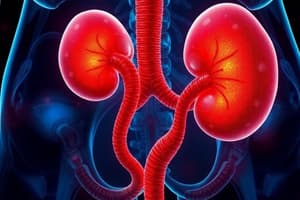Podcast
Questions and Answers
What is the primary difference between nephrolithiasis and urolithiasis?
What is the primary difference between nephrolithiasis and urolithiasis?
- Urolithiasis occurs in the kidneys only.
- Nephrolithiasis refers to stones in the kidney. (correct)
- Urolithiasis is limited to organic stones.
- Nephrolithiasis is only found in the bladder.
Which of the following conditions promotes the formation of urinary stones?
Which of the following conditions promotes the formation of urinary stones?
- High urine pH.
- Increased hydration levels.
- High concentration of citrate in urine.
- Supersaturation of salts in urine. (correct)
What diagnostic tool is recommended for adults presenting with suspected urinary stones?
What diagnostic tool is recommended for adults presenting with suspected urinary stones?
- Low-dose non-contrast CT scan. (correct)
- X-ray imaging only.
- Endoscopic examination.
- Magnetic resonance imaging (MRI).
Which of the following substances acts as an inhibitor in the formation of urinary stones?
Which of the following substances acts as an inhibitor in the formation of urinary stones?
What symptom is commonly associated with a ureteral stone?
What symptom is commonly associated with a ureteral stone?
Which of the following reflects a common risk factor for the development of urinary stones?
Which of the following reflects a common risk factor for the development of urinary stones?
Which method is preferred for managing small urinary stones?
Which method is preferred for managing small urinary stones?
In the context of stone formation, what does nucleation refer to?
In the context of stone formation, what does nucleation refer to?
Flashcards
Nephrolithiasis
Nephrolithiasis
The presence of stones (calculi) in the kidney.
Supersaturation
Supersaturation
A state where the concentration of salts in urine is higher than their normal solubility. This encourages the formation of crystals.
Nucleation
Nucleation
The initial step in stone formation, where ions cluster to form a nucleus for crystals to grow.
Inhibitors and Promoters
Inhibitors and Promoters
Signup and view all the flashcards
Urolithiasis
Urolithiasis
Signup and view all the flashcards
Diagnostic approach for urinary stones
Diagnostic approach for urinary stones
Signup and view all the flashcards
Treatment options for urinary stones
Treatment options for urinary stones
Signup and view all the flashcards
Hematuria
Hematuria
Signup and view all the flashcards
Study Notes
Nephrolithiasis and Urolithiasis
- Overview: This lecture covers epidemiology, etiology, pathophysiology, clinical presentation, and management of kidney stones. Mechanisms of stone formation, classification, and clinical implications are discussed. High-yield exam material on causes, risk factors, diagnosis, and treatment are highlighted.
Learning Objectives
- Objective 1: Understand the prevalence of urolithiasis.
- Objective 2: Describe the origins and mechanisms of stone formation.
- Objective 3: Identify common types of stones and risk factors for their development.
- Objective 4: Differentiate between nephrolithiasis and urolithiasis.
- Objective 5: Outline clinical assessments and management strategies for kidney stones.
Key Concepts and Definitions
- Urolithiasis: Abnormal formation and retention of solid concretions (stones) in the urinary tract (kidney, ureter, bladder).
- Nephrolithiasis: Stones located in the kidneys.
- Supersaturation: Urine salt concentration surpassing solubility, leading to crystal formation.
- Nucleation: Initial clustering of ions, forming a crystal nucleus.
- Inhibitors/Promoters: Substances hindering/promoting crystal growth. Examples include citrate (inhibitor), low urine pH (promoter).
Clinical Applications
- Case Study: 45-year-old man with flank pain, radiating to groin, nausea, hematuria, and a 6mm ureteral stone.
- Diagnostic Approach: Low-dose non-contrast CT scan for adults or ultrasound for children, pregnant patients.
- Treatment Options: Watchful waiting (small stones), medical expulsive therapy (alpha-blockers), shockwave lithotripsy, ureteroscopy, or percutaneous nephrolithotomy (larger stones).
Complications/Management
- Key Complications: Urinary tract obstruction, infection, and kidney abscess (rarely).
- Chronic Kidney Disease: Potential long-term consequence.
Pathophysiology
- Supersaturation and Crystallization: Urine solutes forming a solid phase due to supersaturation, initiating nucleation, crystal growth, and aggregation.
- Inhibitors of Stone Formation: Citrate binds calcium, reducing supersaturation; magnesium and high urine flow also inhibit formation.
Pharmacology
- Calcium Stones: Potassium citrate to increase urine pH, thiazide diuretics to reduce calcium excretion.
- Uric Acid Stones: Alkalinization of urine with potassium citrate or sodium bicarbonate.
- Medical Expulsive Therapy: Alpha-blockers to help stones pass.
Differential Diagnoses
- Pyelonephritis: Flank pain with fever.
- Musculoskeletal Pain: Pain related to movement improvements at rest.
- Appendicitis: Right lower quadrant tenderness.
- Cholecystitis: Right upper quadrant tenderness with Murphy's sign.
- Diverticulitis: Left lower quadrant tenderness.
- Testicular Torsion: Acute testicular pain.
- Ovarian Torsion: Adnexal tenderness with acute pelvic pain.
Investigations
- Urine Analysis: Dipstick for hematuria, nitrites, and leukocyte esterase.
- Blood Tests: Serum calcium, uric acid, metabolic profile.
- Imaging: Low-dose non-contrast CT (preferred) or ultrasound (for children, pregnant women).
Studying That Suits You
Use AI to generate personalized quizzes and flashcards to suit your learning preferences.




